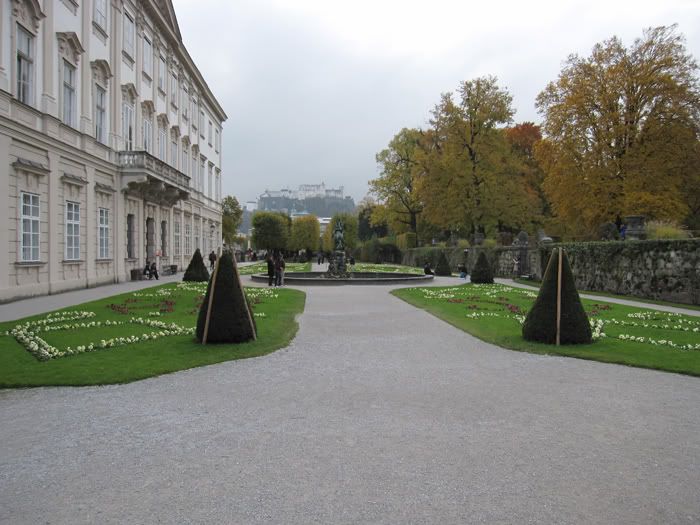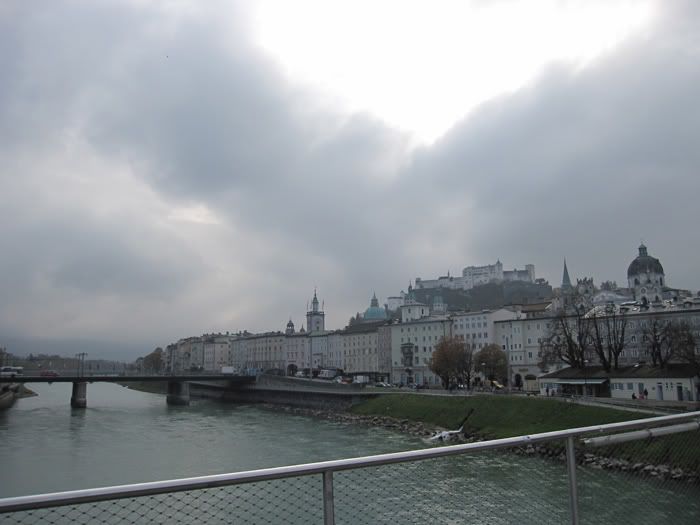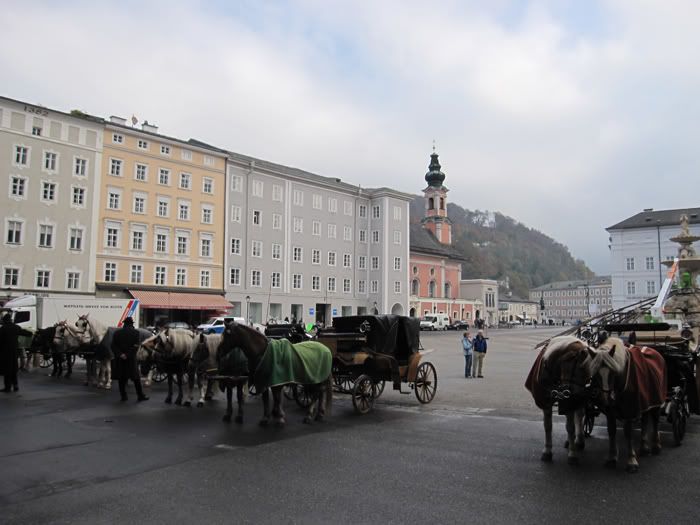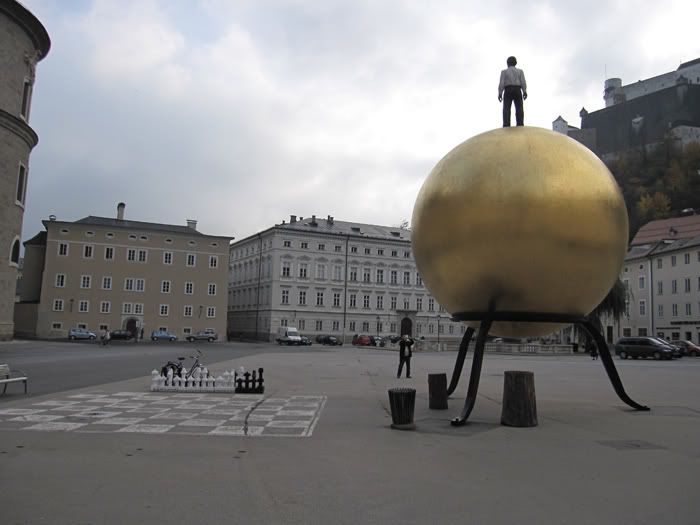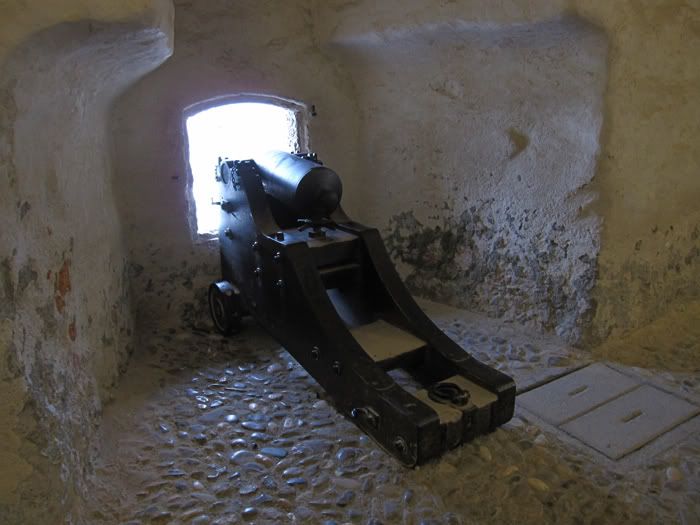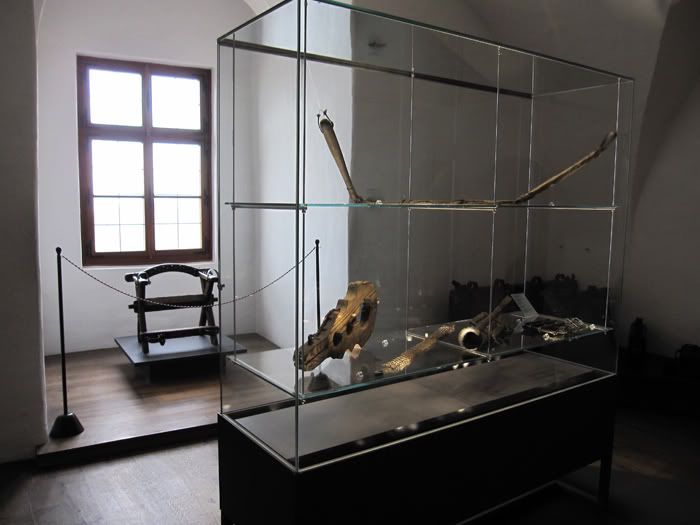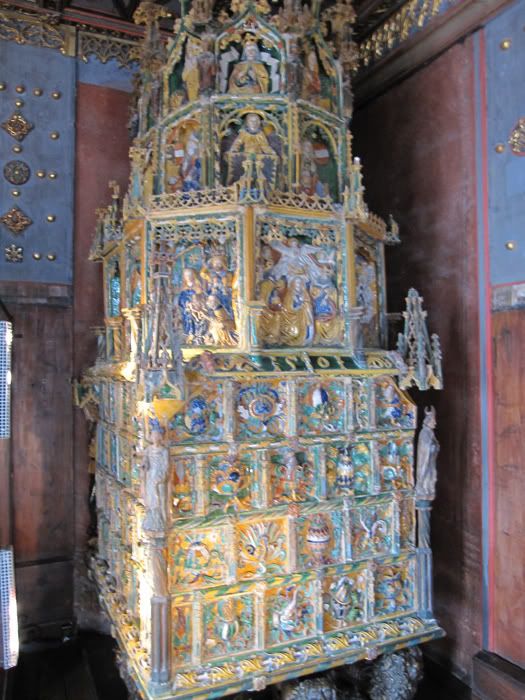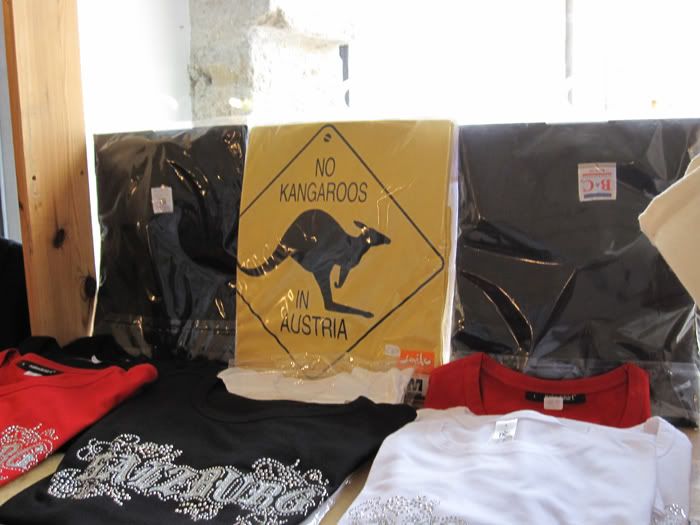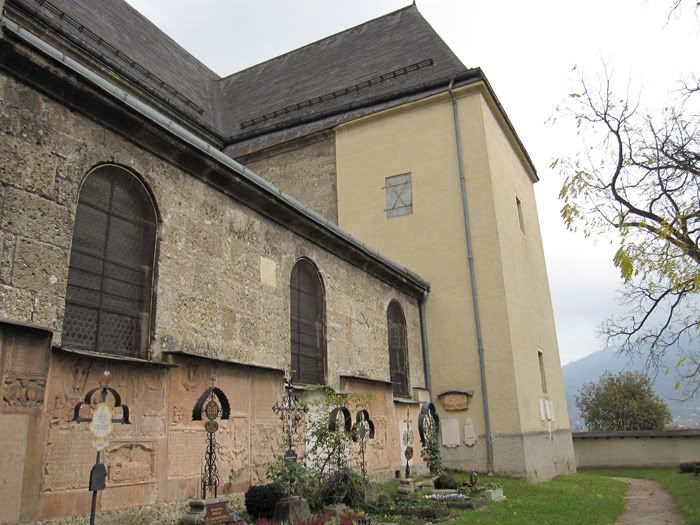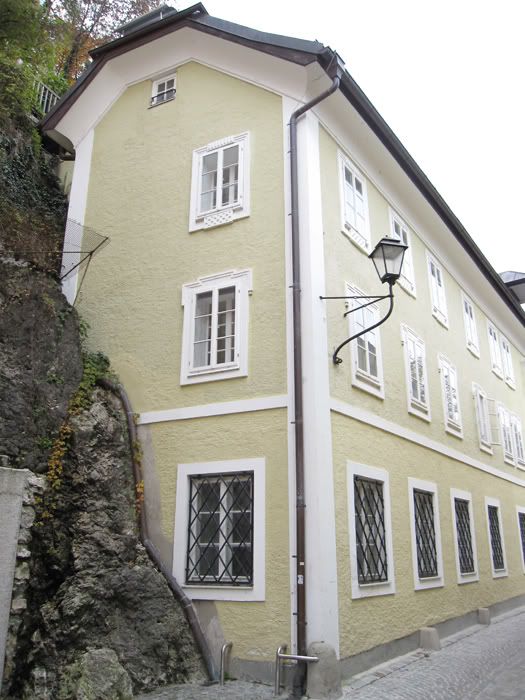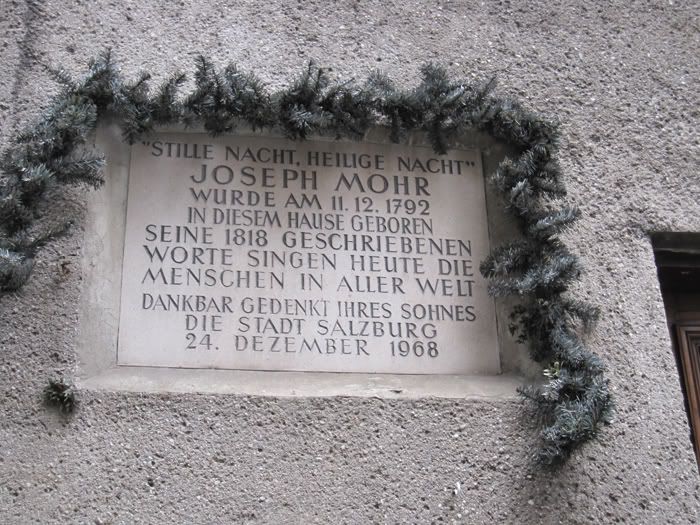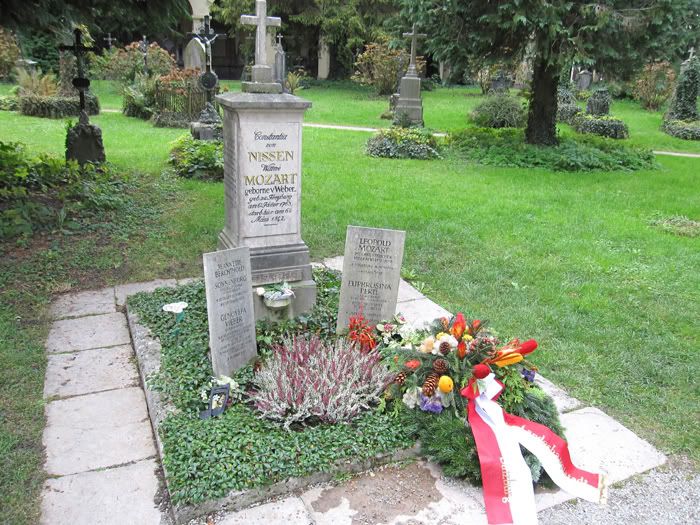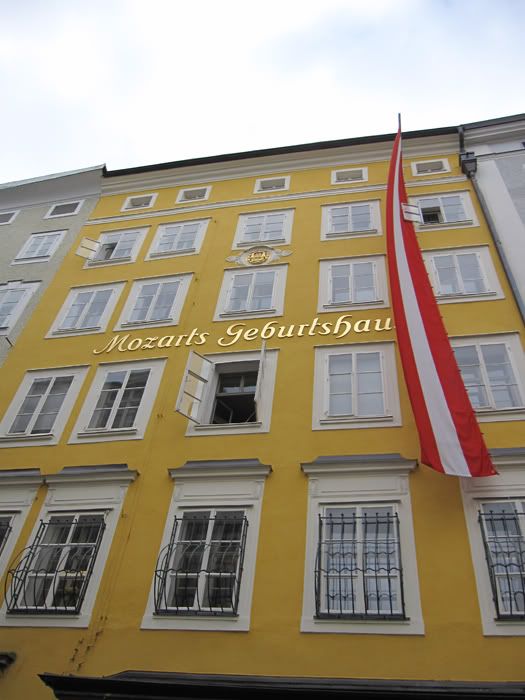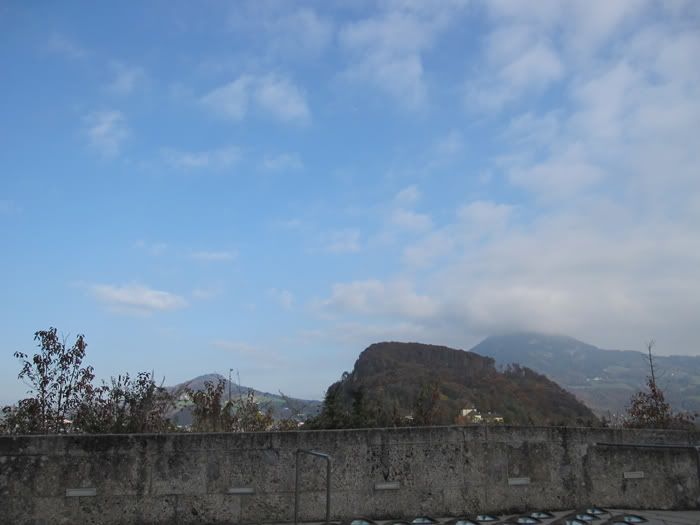As I recap my Europe trip (now 5 months in the past), I have a very good reminder of that trip today. Namely, the very star of this trip, the European Delivery Mercedes-Benz E-class, is now sitting in my garage. Ever since the end of this trip, it had been a sleeping beauty - first on a transatlantic freighter, then in my folks' garage. I needed to drive it a bit during my folks' absence, in order to keep it in good working order; and of course, I also wanted to re-live the memories.
Back to the recap. This post covers Friday, October 30, 2009, which had me explore Salzburg, Austria, on foot all day, with no driving involved. At the Best Western I was staying at, I found that I had free Internet access in the lobby; this was a big deal, since most other places wanted to charge me about €8 per hour on average. Taking advantage of this, I made sure to do some of my sightseeing research while I could - and also catch up with work email.
The Best Western also provided me with complimentary hot breakfast buffet, hearty enough to last me all day.
The sightseeing began with a short walk to Mirabell Palace and its gardens. Due to the timing of my visit, I could not see much in the way of actual roses. But this is certainly a familiar angle; behind me are some stone steps, and this is where the last few phrases of "Do, Re, Mi" were sung in the 1965 movie adaptation of the musical, The Sound of Music.
And if that fortress in the distance, Hohensalzburg, doesn't tell me I'm in Salzburg, I don't know what does. I am remindful of the fact that for the first time in ten years, I am exploring a brand-new European country. So far, I am grateful that I am connecting with the locals quite well, and that I am doing a reasonably good job of putting those Amsterdam demons from 1999 to rest. At least Austria is another Germanic country, so signs remain in familiar-by-now German and it's not too difficult to figure things out.
My first sight, in fact, will be Hohensalzburg Fortress. Hohensalzburg means "Upper Salzburg." And Salzburg, for that matter, means "Salt Fortress," due to huge deposits of salt in the surrounding areas. Salzburg had built its fortune on mining and exporting its salt, and the Salzach River, which I'm crossing, was the main means of transportation for exporting salt.
The Salzach is spanned by several bridges, some of them footbridges, some vehicular. I am crossing from Mirabell Gardens toward the Altstadt (old town), and getting up to Hohensalzburg will require me to walk through Altstadt.
I am still walking toward Hohensalzburg, having passed through most of Altstadt. I am now passing through a large square near the main cathedral.
I am loving the sight of these horse carriages. The Sound of Music had had the seven children and Maria riding through Altstadt on one of them.
Also in The Sound of Music, this square was featured in a scene - being heavily covered with Nazi insignia, in the wake of the Anschluss (the annexation of Austria by Nazi Germany). The movie (and the musical), of course, had featured Captain Von Trapp, and a key element of the storyline was his principled, strong opposition to the Nazis.
Another, smaller plaza, as I near the funicular that will bring me up to Hohensalzburg.
On the right, the ball is a piece of artwork. And the boy on top of the ball - not real, but part of the artwork too.
On the left, there is a giant chess set and board. Nobody is playing chess on this cool, overcast day, however.
Now I have entered the fortress.
This cannon, along with the thick wall, is a reminder that Hohensalzburg, unlike the Mad King Ludwig fantasy castles, is a real fortress built with defense as a key consideration. Its history stretches back almost a thousand years, and the fortress was rebuilt and expanded several times over its lifetime. And thanks to its sturdy defenses, it was never successfully overrun by invaders.
In medieval times, torture was a very common means of punishment. Here are some torture instruments.
The interior areas of the fortress are managed as museums, some of them showcasing the rulers' living quarters and others dedicated to military history and other relevant topics.
Here is a three-tiered fireplace. This ceramic contraption carries motifs that represent the royal coat of arms, Christian beliefs, and more.
This fireplace is very similar to fireplaces I had seen, but couldn't photograph, over at the fantasy castles.
Modern-day heating is done via electric heaters. And I am walking on an elevated walkway, to protect the royal quarters' original wooden floors. Compared to contemporary buildings, this place was state of the art; while indoor plumbing was an unknown (and would remain so for a few more centuries), I could see an indoor toilet at a bedroom (though I am pretty sure that it would've smelled very badly, and had to be manually emptied by servants).
Seen at a souvenir shop within Hohensalzburg: this souvenir T-shirt. And it's a common sight throughout Salzburg.
Of course, most international visitors easily mix up Austria and Australia. But it bears remembering that Australia is Southern Land, based on the Latin word austral, while Austria's correct spelling is Österreich, or Eastern Kingdom.
Austria, of course, forms the eastern portions of traditional Germanic territory. While most Germans lived in a Holy Roman Empire that was a collection of a few hundred independent principalities, Austria was ruled by the powerful Habsburgs early on, and was a strong, well-defined nation-state that also included Hungary and the Magyar people until World War I. In fact, modern-day Germany, dating back only to 1871, consists of the Germanic territory that Austria didn't cover - and even then, about half of it was lost through the two World Wars.
In fact, Austrians seem to see themselves as the true heritage keepers of the Germanic people. And they note that by using the Austrian flag, rather than the German flag, to denote that a given caption/service is provided in German (alongside British/American split flag for English, French tricouleurs for French, and so forth).
Leaving the fortress, I stayed close to the hill, and went through some very narrow, steep alleyways, with good peeks into some apartment balconies and private backyards. That led me to this place - Nonnberg Convent.
Of course, this is where the nuns in The Sound of Music lived, including aspiring nun Maria.
There is a cemetery outside for past nuns as seen in the photo, and inside, there is a dark yet cozy and lovely sanctuary. A 50-cent coin illuminates some old paintings in the back of the sanctuary, but of course, I declined that option.
The views of the southwestern fringes of town, from the street just outside the convent, are marvelous, with green hills and beautiful houses framed by jagged mountains. Truly, the hills are alive, with the sound of music...
Crossing back to the Mirabell side, I am now walking an alley called Steingasse, which runs southeast out of town. It may be a very narrow back alley today, but it was the main Roman trading road back in its day.
This house is very typical of buildings built on Steingasse - and in many other parts of Salzburg. Due to the steep rocky hills and cliffs that characterize the city terrain, many buildings are built with very little depth, as seen here. And the cliff wall simply becomes the back wall of the house.
Of course, rocks fall from the cliff often, and some falling rock used to result in damaged buildings and even dead occupants. Rock climbers, removing loose rock before they became rock slides, became a very important occupation in Salzburg as a result.
Seen at the No. 9 house on Steingasse: this marker claims that Joseph Mohr, the composer of the well-known Christmas tune "Silent Night, Holy Night," was born at this house on December 11th, 1792.
I found this marker thanks to my Fodor's guidebook covering both Bavaria and Salzburg. The guidebook, however, noted that Mohr's actual birthplace was No. 31, rather than this house.
Salzburg certainly has more music connections than the impressive credentials already established by Mozart and The Sound of Music.
Emerging out of Steingasse onto a more populated pedestrian street, I did some window shopping at a few of the stores lining the eastbound street.
I am at a church cemetery. This is the grave of Constance Mozart, the wife of the famous composer Wolfgang Amadeus Mozart. Mozart himself was thrown into an unmarked grave - the 1984 movie Amadeus had that scene.
And back to that 1965 The Sound of Music movie, this cemetery was the scene where the Von Trapp family hid out while trying to run from the Nazis, and where Rolfe, the former telegram delivery boy turned into a Nazi soldier, faced off with Captain Von Trapp who was trying to talk him out of Nazism. Rolfe eventually stuck to Nazism - and the family ran away using the nunnery car toward nearby mountains, then walking their way to neutral Switzerland. (Of course, in real life, Switzerland is 100 miles away, but the musical and the movie moved Switzerland closer for dramatic effect.)
Salzburg feels very religious, just like Bavaria, only a few miles away. In fact, the Bavarian greeting "Grüß Gott" (God's Greetings), used nowhere else in the German-speaking world, could be seen at a restaurant nearby.
Salzburg preserves two Mozart houses. The one in front of Mirabell Palace is where Mozart grew up as a teen. And this one in Altstadt is where he was born.
There are some exhibits in here, but very few of them really belong to Mozart and his family. This was a mere rental apartment back in the day.
And this is where my walking tour ends for the day.
Using a pay elevator, I climbed up Mönchsberg, a rocky cliff just northwest of Altstadt. This is where Julie Andrews, playing Maria, taught the seven Von Trapp children the basics of singing, with that famous song "Do, Re, Mi." I am not at that exact spot, however; this is as close as I can get, as the exact spot now has a modern art museum, erected in 2004.
Of course, the challenge is to run down the hill on foot (rather than cheating with an elevator), ride all over Altstadt on a horse carriage, then run to Mirabell Gardens to finish the song off, all in the space of just a few minutes. I couldn't do it. Even cheating by using the elevator, I simply couldn't see how I could run across the river back to Mirabell Gardens and continue singing in that timeframe; I figured I'd need 15 minutes (and I'd be out of breath and unable to sing) for myself, and 30 minutes at least for the youngest Von Trapp children.
It was only mid-afternoon when I returned to the hotel. My initial plan was to attend a Mozart concert in the early evening hours - after all, it'd be only appropriate as part of a visit to his hometown. But after the jet lag-induced nap stretched too long, neither my mother nor I felt like going out on the town again - so this was all the Salzburg I ended up seeing and experiencing. I will have to return on a future visit to this part of the world - combining with Munich again.
Another reason to return: I ended up not visiting any of the salt mines in the area. The nearest one, Hallein, was only a short drive away on Autobahn 10, with ample free parking according to the mine's website, but my mother simply wanted to have none of me driving more than absolutely necessary, by the time I was starting to make my drive out of Salzburg the next morning. The next post, covering Halloween 2009, will start with the skipping of the salt mines, and will cover my drive over the Brenner Pass into Italy, with some first impressions of Venice.
